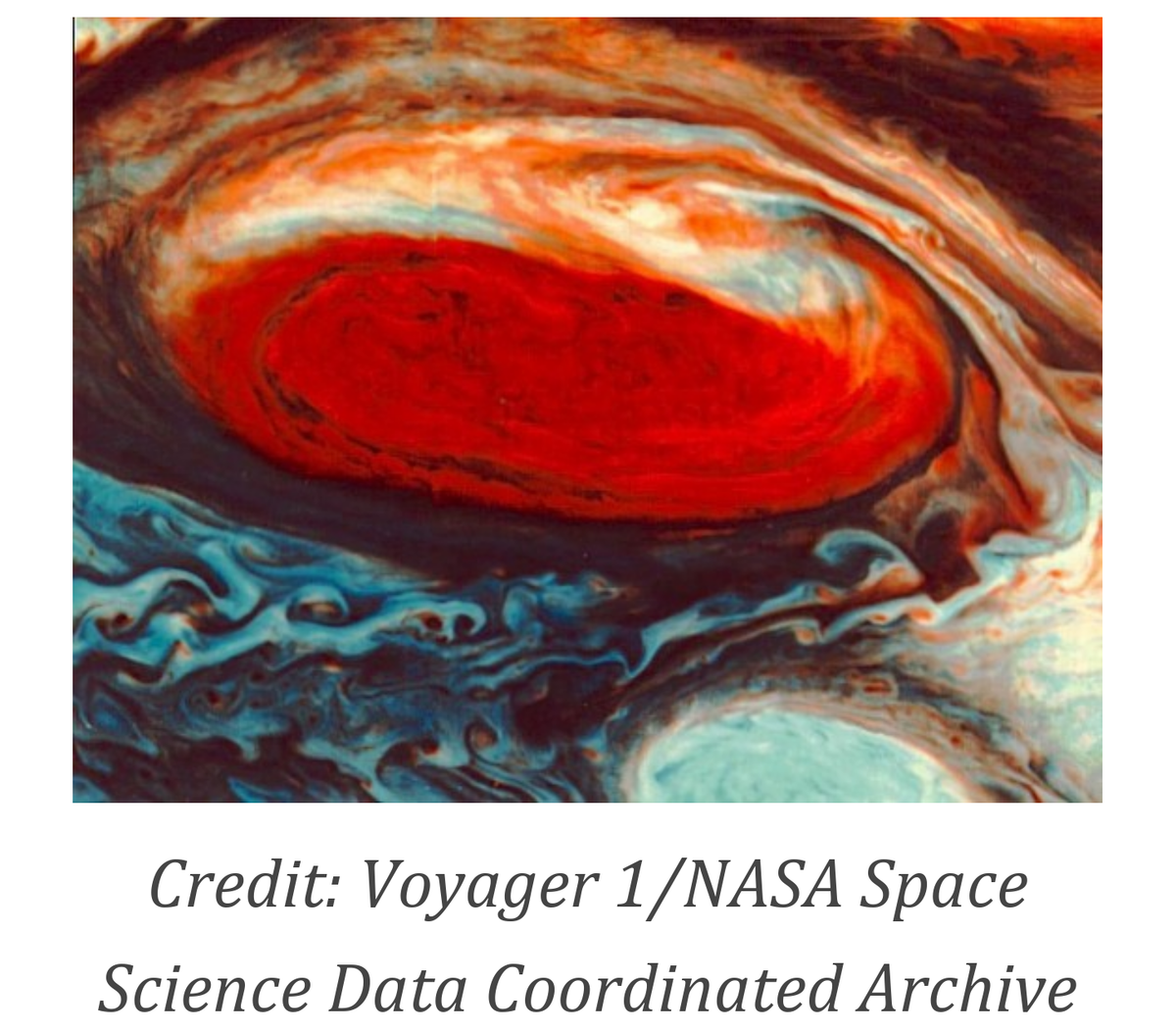[The Thunder Sounds His Praises 雷は彼の賛美を鳴らす]
Stephen Smith August 19, 2015Picture of the Day

False color image of the Great Red Spot.
大赤斑の偽色画像。
――――――――
Aug 19, 2015
大赤斑は、予想とは異なる場合があります。
最近の「今日の写真」で述べたように、ジュノ・ミッションは2016年7月に木星の周りの軌道に入る予定です。
ミッションの主なターゲットの1つは、木星の大気中の大赤斑です。
スポットは、それを研究する望遠鏡がある限り存続します:
300年以上。
天文学者はそれが下からの対流熱によって駆動されるサイクロンの嵐であると考えています。
しかしながら、それがどのように形成されたのか、なぜそれが長い間続いているのかは謎のままです。
巨大な楕円形はサイズが異なります、長さ約20,000キロから約40,000キロ、最大幅は約21,000キロです。
地球の直径の、12,800 kmは、比較すると小さく見えます。
大赤斑の周囲の風速は、時速635 kmで測定されました、地上の竜巻の2倍の速さです。
2010年3月、ヨーロッパ南天天文台(ESO)のベリー・ ラージ・テレスコープが、スポットの温度マップの変化を検出しました。
観測により、その中心に暖かい地域が明らかになりました、最も深い赤色に対応します。
惑星の科学者は、スポットの渦の中心のより暖かい領域がその回転を動かすのに十分であると信じています。
「ウォーム」は相対的な用語です、大赤斑の平均気温は-160度です。
その赤い色の起源は
―大気中の化学変化または下からの物質の湧昇からです
—さらなる調査が必要です。
ジェット推進研究所のグレン・オートンは、この様に書いています:
「私たちはかつて、大赤斑があまり構造のない単純な古い楕円形だと思っていましたが、これらの新しい結果は、実際には非常に複雑であることを示しています。
天文学者達は、ガス巨星がそれぞれ独特の全体的な色を示す理由がわかりません。
望遠鏡によれば、海王星は青色、天王星は緑色、土星は淡い黄色の面を、そして、木星はさびた赤い外観をしています。
ガスの巨大な色と木星の謎めいたマーキング、特に大赤斑は、まったく異なる起源を持つ可能性があります。
内部で発生した熱と対流ではなく、木星の乱気流は外部のエネルギー源からエネルギーを受け取っている可能性があります。
ました、巨大な「プラズマ・トルネード」またはフラックス・チューブは、宇宙から地球の磁気圏に入ります。
〈http://www.thunderbolts.info/tpod/2009/arch09/090630breaches.htm〉
それらはTHEMIS人工衛星によって発見されました。
このチューブは時速150万キロ以上で回転し、10万アンペア以上の電荷フローを生成します。
フラックス・チューブは、フィラメントのツイスト・ペアを形成する電磁界です。
これらの糸状構造は、最初にそれらを発見した人、クリスチャン・バークランドにちなんで名付けられました。
バークランド電流は磁力線に従い、帯電した物質を周囲から引き込みます、重力よりも桁違いに大きな力でそれを電気力学的に分類します。
ESOの調査員が目撃している可能性があるのは、木星の帯電した環境へのプラズマ・フィラメントの流入です。
木星の画像では、赤点の周囲にいくつかの明るい点が円弧状に並んでいます。
スポットの下には、別の明るい弧の形があり、赤外線放射の増加を示しています。
バークランド電流は互いに回転し、かなり多くのストランドから始まります。
最初は、56本のフィラメントが28本に融合し、次に14本という具合になります。
より多くの電荷が回路を流れると、フィラメントの数は減少しますが、各ペアはよりエネルギー的になります。
バークランド電流が交差する場所では、プラズマ密度が増加するとZピンチが発生し、熱(およびその他の)放射が放出されます。
むしろ、対流と暖かいガスではなく、大赤斑は、おそらく外部の電磁界のために回転しています。
大赤斑と木星の大気中の他の渦は、バークランド電流が巨大惑星と相互作用する場所かもしれません。
スティーブン・スミス
――――――――
Aug 19, 2015
The Great Red Spot could be something different than what is expected.
大赤斑は、予想とは異なる場合があります。
As mentioned in a recent Picture of the Day, the Juno mission is slated to enter orbit around Jupiter in July of 2016.
最近の「今日の写真」で述べたように、ジュノ・ミッションは2016年7月に木星の周りの軌道に入る予定です。
One of the mission’s primary targets is the Great Red Spot in Jupiter’s atmosphere.
ミッションの主なターゲットの1つは、木星の大気中の大赤斑です。
The Spot has persisted for as long as there have been telescopes to study it:
more than 300 years.
スポットは、それを研究する望遠鏡がある限り存続します:
300年以上。
Astronomers think that it is a cyclonic storm driven by convective heat from below.
天文学者はそれが下からの対流熱によって駆動されるサイクロンの嵐であると考えています。
However, exactly how it was formed and why it has persisted for so long remain a mystery.
しかしながら、それがどのように形成されたのか、なぜそれが長い間続いているのかは謎のままです。
The giant oval varies in size, from approximately 20,000 kilometers long to almost 40,000 kilometers, with a maximum width of around 21,000 kilometers.
巨大な楕円形はサイズが異なります、長さ約20,000キロから約40,000キロ、最大幅は約21,000キロです。
Earth looks small in comparison at 12,800 kilometers in diameter.
地球の直径の、12,800 kmは、比較すると小さく見えます。
Wind speeds around the perimeter of the Great Red Spot are measured at 635 kilometers per hour, twice as fast as a terrestrial tornado.
大赤斑の周囲の風速は、時速635 kmで測定されました、地上の竜巻の2倍の速さです。
In March of 2010, the European Southern Observatory’s (ESO) Very Large Telescope detected variations in the temperature map of the spot.
2010年3月、ヨーロッパ南天天文台(ESO)のベリー・ ラージ・テレスコープが、スポットの温度マップの変化を検出しました。
Observations revealed a warmer region at its center, corresponding to the deepest red color.
観測により、その中心に暖かい地域が明らかになりました、最も深い赤色に対応します。
Planetary scientists believe that the warmer areas in the center of the spot’s vortex are sufficient to drive its rotation.
惑星の科学者は、スポットの渦の中心のより暖かい領域がその回転を動かすのに十分であると信じています。
“Warm” is a relative term, since the Great Red Spot’s temperature averages -160 Celsius.
「ウォーム」は相対的な用語です、大赤斑の平均気温は-160度です。
The origin of its red color—from chemical changes in the atmosphere or upwelling of material from below—requires further study.
その赤い色の起源は
―大気中の化学変化または下からの物質の湧昇からです
—さらなる調査が必要です。
As Glenn Orton from the Jet Propulsion Laboratory wrote:
“We once thought the Great Red Spot was a plain old oval without much structure, but these new results show that it is, in fact, extremely complicated.”
ジェット推進研究所のグレン・オートンは、この様に書いています:
「私たちはかつて、大赤斑があまり構造のない単純な古い楕円形だと思っていましたが、これらの新しい結果は、実際には非常に複雑であることを示しています。
Astronomers are not sure why the gas giants each exhibit a unique overall color.
天文学者達は、ガス巨星がそれぞれ独特の全体的な色を示す理由がわかりません。
Telescopes reveal that Neptune has a blue color, Uranus a green hue, Saturn a pale yellow aspect, and Jupiter a rusty red appearance.
望遠鏡によれば、海王星は青色、天王星は緑色、土星は淡い黄色の面を、そして、木星はさびた赤い外観をしています。
Gas giant coloration and Jupiter’s enigmatic markings, especially the Great Red Spot, could have a different origin altogether.
ガスの巨大な色と木星の謎めいたマーキング、特に大赤斑は、まったく異なる起源を持つ可能性があります。
Rather than internally generated heat and convection, Jupiter’s turbulent atmosphere might be receiving its energy from an external source.
内部で発生した熱と対流ではなく、木星の乱気流は外部のエネルギー源からエネルギーを受け取っている可能性があります。
Previous Pictures of the Day note that gigantic “plasma tornadoes,” or flux tubes, enter Earth’s magnetosphere from space.
以前の「今日の写真」で指摘しました、巨大な「プラズマ・トルネード」またはフラックス・チューブは、宇宙から地球の磁気圏に入ります。
〈http://www.thunderbolts.info/tpod/2009/arch09/090630breaches.htm〉
They were found by the fleet of THEMIS satellites.
それらはTHEMIS人工衛星によって発見されました。
The tubes are rotating at more than 1.5 million kilometers per hour and generating over 100,000 amps of electric charge flow.
このチューブは時速150万キロ以上で回転し、10万アンペア以上の電荷フローを生成します。
The flux tubes are electromagnetic fields forming twisted pairs of filaments.
フラックス・チューブは、フィラメントのツイスト・ペアを形成する電磁界です。
These filamentary formations are named after the one who originally discovered them, Kristian Birkeland.
これらの糸状構造は、最初にそれらを発見した人、クリスチャン・バークランドにちなんで名付けられました。
Birkeland currents follow magnetic field lines and draw charged material from their surroundings, electrodynamically sorting it with a force that can be orders of magnitude greater than gravity.
バークランド電流は磁力線に従い、帯電した物質を周囲から引き込みます、重力よりも桁違いに大きな力でそれを電気力学的に分類します。
What ESO investigators could be witnessing is the influx of plasma filaments into Jupiter’s electrically charged environment.
ESOの調査員が目撃している可能性があるのは、木星の帯電した環境へのプラズマ・フィラメントの流入です。
In an image of Jupiter, several bright points can be seen surrounding the Red Spot in an arc-shaped array.
木星の画像では、赤点の周囲にいくつかの明るい点が円弧状に並んでいます。
Below the spot is another bright arc-shape, indicative of increased infrared radiation emissions.
スポットの下には、別の明るい弧の形があり、赤外線放射の増加を示しています。
Birkeland currents rotate around each other, beginning as many strands.
バークランド電流は互いに回転し、かなり多くのストランドから始まります。
At first, there might be 56 filaments that merge into 28, then 14, and so on.
最初は、56本のフィラメントが28本に融合し、次に14本という具合になります。
As more charge flows through the circuit, the number of filaments reduces, but each pair becomes more energetic.
より多くの電荷が回路を流れると、フィラメントの数は減少しますが、各ペアはよりエネルギー的になります。
Where Birkeland currents intersect, z-pinches occur as plasma density increases, releasing thermal (and other) radiation.
バークランド電流が交差する場所では、プラズマ密度が増加するとZピンチが発生し、熱(およびその他の)放射が放出されます。
Rather than convection and warm gas, the Great Red Spot is probably rotating because of external electromagnetic fields.
むしろ、対流と暖かいガスではなく、大赤斑は、おそらく外部の電磁界のために回転しています。
The Great Red Spot, as well as other vortices in Jupiter’s atmosphere, could be where Birkeland currents interact with the giant planet.
大赤斑と木星の大気中の他の渦は、バークランド電流が巨大惑星と相互作用する場所かもしれません。
Stephen Smith
スティーブン・スミス